Preste atenção aos velhos sinais de abrigo? Se o nuke está REALMENTE chegando, talvez não
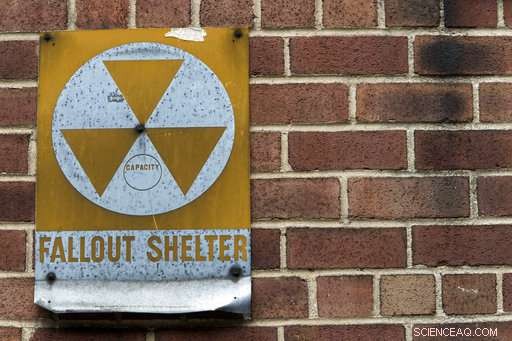 p Nesta terça, 16 de janeiro Foto 2018, uma placa de abrigo radioativo está pendurada em um prédio na East 9th Street em Nova York. Os abrigos radioativos, marcados com sinais de metal com o símbolo da radiação - três triângulos unidos dentro de um círculo - foram instalados em dezenas de milhares de edifícios em todo o país no início dos anos 1960 em meio à corrida armamentista nuclear. Somente na cidade de Nova York, acreditava-se que havia cerca de 18, 000. (AP Photo / Mary Altaffer)
p Nesta terça, 16 de janeiro Foto 2018, uma placa de abrigo radioativo está pendurada em um prédio na East 9th Street em Nova York. Os abrigos radioativos, marcados com sinais de metal com o símbolo da radiação - três triângulos unidos dentro de um círculo - foram instalados em dezenas de milhares de edifícios em todo o país no início dos anos 1960 em meio à corrida armamentista nuclear. Somente na cidade de Nova York, acreditava-se que havia cerca de 18, 000. (AP Photo / Mary Altaffer)
p Uma geração de americanos sabia exatamente o que fazer no caso de um ataque nuclear - ou durante um grande alarme falso, como aquele do fim de semana no Havaí. Proteja-se em um prédio com um símbolo amarelo de abrigo anti-precipitação. p Mas hoje em dia, essa pode não ser a melhor opção, ou mesmo uma opção.
p Relíquias da Guerra Fria, os abrigos antigos que antes chegavam aos milhares nas escolas, tribunais e igrejas não foram mantidos. E a sabedoria convencional mudou sobre se esse sistema de abrigo é necessário em uma época em que é mais provável que um ataque venha de um estado fraco ou grupo terrorista, em vez de uma superpotência.
p "Não estamos em um cenário de Guerra Fria. Estamos em 2018, "disse o Dr. Irwin Redlener, chefe do Centro Nacional de Preparação para Desastres do Instituto da Terra da Universidade de Columbia. "Não estamos enfrentando o que enfrentávamos há 50 anos, quando a União Soviética e os EUA tiveram ogivas nucleares apontadas uma para a outra que devastaria o mundo. Há uma ameaça, mas é um tipo diferente de ameaça hoje. "
p As pessoas não sabiam o que fazer no sábado, quando o Havaí por engano enviou um alerta de celular avisando sobre um míssil balístico se aproximando e não o retraiu por 38 minutos. O estado montou a infraestrutura de alerta de mísseis depois que a Coréia do Norte demonstrou que seus mísseis tinham alcance para atingir as ilhas. Os motoristas abandonaram os carros em uma rodovia e se abrigaram em um túnel. Pais amontoados em banheiras com seus filhos. Os alunos dispararam pelo campus da Universidade do Havaí para se protegerem nos prédios.
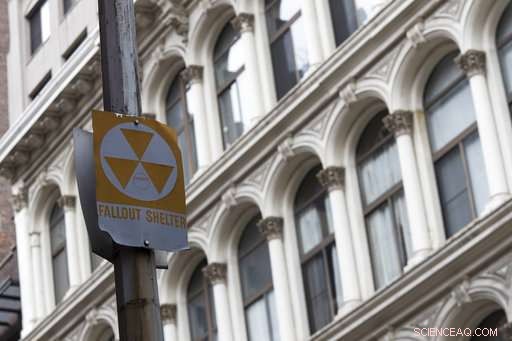 p Nesta terça, 16 de janeiro Foto 2018, Placas de abrigo radioativo estão penduradas em um poste na East 11th Street em Nova York. Em um verdadeiro ataque nuclear, proteger-se em um prédio com o símbolo amarelo enferrujado de um abrigo anti-precipitação pode não ser mais a melhor opção. Especialistas dizem que os abrigos em escolas e tribunais costumam ser relíquias antigas da Guerra Fria que não foram mantidas. (AP Photo / Mary Altaffer)
p Nesta terça, 16 de janeiro Foto 2018, Placas de abrigo radioativo estão penduradas em um poste na East 11th Street em Nova York. Em um verdadeiro ataque nuclear, proteger-se em um prédio com o símbolo amarelo enferrujado de um abrigo anti-precipitação pode não ser mais a melhor opção. Especialistas dizem que os abrigos em escolas e tribunais costumam ser relíquias antigas da Guerra Fria que não foram mantidas. (AP Photo / Mary Altaffer)
p O alarme falso é o momento perfeito para falar sobre o que fazer em uma emergência, Redlener disse, porque na maioria das vezes as pessoas não querem falar sobre isso. Em absoluto.
p "Mas é uma possibilidade real, "ele disse." As autoridades municipais deveriam estar falando sobre o que seus cidadãos deveriam fazer se um ataque acontecesse. E é uma necessidade que as pessoas e as famílias conversem sobre e desenvolvam seus próprios planos do que fariam. "
p Os nova-iorquinos que foram questionados esta semana sobre onde buscariam abrigo durante um ataque com mísseis disseram que não tinham ideia.
p "A única coisa que posso pensar é, Eu correria, "disse Sabrina Shephard, 45, de Manhattan. "Para onde correríamos, Eu não sei, porque não sei se Nova York tem abrigos antiaéreos ou algo assim. "
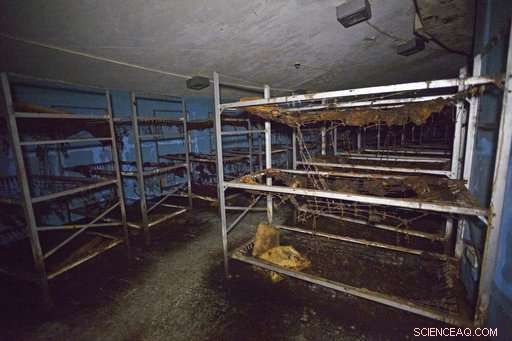 p Nesta terça, 26 de setembro, Foto de 2017, uma baía de beliches pode ser vista em uma sala em forma de meia-lua dentro de um bunker da Defesa Civil da época da Guerra Fria em Nova Orleans. Uma geração de americanos sabia exatamente o que fazer no caso de um ataque nuclear - ou durante um grande alarme falso, como aquele do fim de semana no Havaí. Proteja-se em um prédio com um símbolo amarelo de abrigo anti-precipitação. Mas hoje em dia, essa pode não ser a melhor opção, ou mesmo uma opção. (Max Becherer / The Advocate via AP)
p Nesta terça, 26 de setembro, Foto de 2017, uma baía de beliches pode ser vista em uma sala em forma de meia-lua dentro de um bunker da Defesa Civil da época da Guerra Fria em Nova Orleans. Uma geração de americanos sabia exatamente o que fazer no caso de um ataque nuclear - ou durante um grande alarme falso, como aquele do fim de semana no Havaí. Proteja-se em um prédio com um símbolo amarelo de abrigo anti-precipitação. Mas hoje em dia, essa pode não ser a melhor opção, ou mesmo uma opção. (Max Becherer / The Advocate via AP)
p Os abrigos radioativos, marked with metal signs featuring the symbol for radiation—three joined triangles inside a circle—were set up in tens of thousands of buildings nationwide in the early 1960s amid the nuclear arms race. In New York City alone there were believed to be about 18, 000
p The locations were chosen because they could best block radioactive material. Anything could be a shelter as long as it was built with concrete, cinder blocks or brick, had no windows, and could be retrofitted quickly with supplies, an air filtration system and potable water.
p But the idea was controversial from the start, especially since one of the scenarios at the time, a full-scale nuclear war between the U.S. and the Soviet Union, would have left few survivors. By the 1970s, the concept was abandoned. A FEMA spokeswoman said the agency doesn't even have current information on where the shelters are located.
p New York City education officials announced last month they are taking down the fallout shelter signs at schools. In Minot, North Dakota, just a few miles from the base where dozens of U.S. missiles are at the ready, a few fallout shelter signs remain, but their status as viable refuges isn't known.
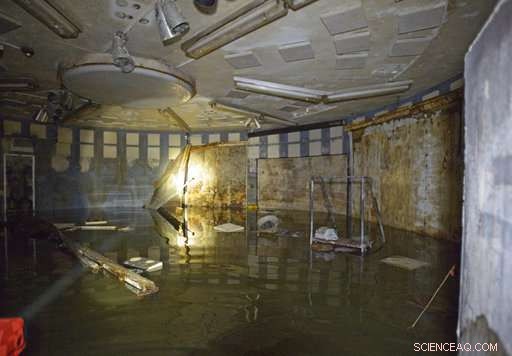 p Nesta terça, 26 de setembro, Foto de 2017, a flashlight illuminates the main command center of a Cold War era Civil Defense bunker in New Orleans. The fallout shelters, marked with metal signs featuring the symbol for radiation - three joined triangles inside a circle - were set up in tens of thousands of buildings nationwide in the early 1960s amid the nuclear arms race. (Max Becherer /The Advocate via AP)
p Nesta terça, 26 de setembro, Foto de 2017, a flashlight illuminates the main command center of a Cold War era Civil Defense bunker in New Orleans. The fallout shelters, marked with metal signs featuring the symbol for radiation - three joined triangles inside a circle - were set up in tens of thousands of buildings nationwide in the early 1960s amid the nuclear arms race. (Max Becherer /The Advocate via AP)
p So what should you do if there is a nuclear attack now?
p The good news:You may actually survive, because a nuclear attack today is more likely to be just one bomb—perhaps a small device, smuggled into a city inside a truck, or a single missile lobbed by North Korea that actually makes it across the water. The bad news:You have between 15 and 20 minutes to get to a safe space.
p Eliot Calhoun, a disaster planner for New York's Emergency Management Department, said the smartest thing to do is stay put in a spot with as few windows and as many walls as possible.
p "Don't go outside unless you absolutely must, " ele disse.
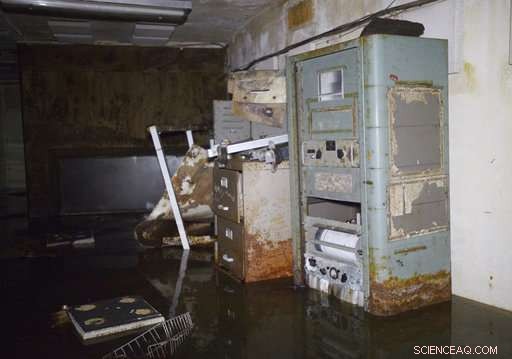 p Nesta terça, 26 de setembro, Foto de 2017, old office equipment stands in a room near the entryway of a Cold War era Civil Defense bunker located in the neutral ground of West End Boulevard near Robert E. Lee Boulevard in New Orleans, La. Relics from the Cold War, the aging shelters that once numbered in the thousands in schools, courthouses and churches haven't been maintained. And conventional wisdom has changed about whether such a shelter system is necessary in an age when an attack is more likely to come from a weak rogue state or terrorist group rather than a superpower. (Max Becherer /The Advocate via AP)
p Nesta terça, 26 de setembro, Foto de 2017, old office equipment stands in a room near the entryway of a Cold War era Civil Defense bunker located in the neutral ground of West End Boulevard near Robert E. Lee Boulevard in New Orleans, La. Relics from the Cold War, the aging shelters that once numbered in the thousands in schools, courthouses and churches haven't been maintained. And conventional wisdom has changed about whether such a shelter system is necessary in an age when an attack is more likely to come from a weak rogue state or terrorist group rather than a superpower. (Max Becherer /The Advocate via AP)
p Subterranean subway stations might be a good place to shelter if you happen to be in one when an attack happens, but experts say tunnels could also be dangerous if they are structurally compromised by a blast.
p New Yorker Joe Carpenter emerged from a post office with a faded fallout shelter sign this week and admitted that he had never thought about what to do in the event of an incoming missile.
p "I probably would just huddle with the masses and go along with the crowd, because I've never really considered it, " he said. "It's like everything else:Do we really ponder what's at the end of the road?"
-
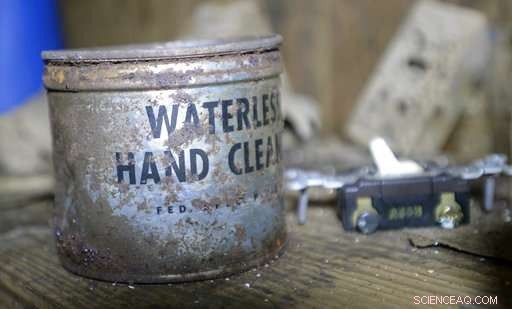 p Nesta terça, 26 de setembro, Foto de 2017, a container of waterless hand cleaner sits in a storage room inside an abandoned Cold War era Civil Defense bunker in New Orleans. Relics from the Cold War, the aging shelters that once numbered in the thousands in schools, courthouses and churches haven't been maintained. And conventional wisdom has changed about whether such a shelter system is necessary in an age when an attack is more likely to come from a weak rogue state or terrorist group rather than a superpower. (Max Becherer /The Advocate via AP)
p Nesta terça, 26 de setembro, Foto de 2017, a container of waterless hand cleaner sits in a storage room inside an abandoned Cold War era Civil Defense bunker in New Orleans. Relics from the Cold War, the aging shelters that once numbered in the thousands in schools, courthouses and churches haven't been maintained. And conventional wisdom has changed about whether such a shelter system is necessary in an age when an attack is more likely to come from a weak rogue state or terrorist group rather than a superpower. (Max Becherer /The Advocate via AP)
-
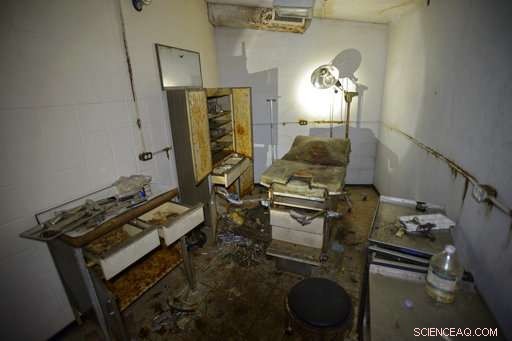 p Nesta terça, 26 de setembro, Foto de 2017, an infirmary complete with a medical bed and medical instruments is seen inside a Cold War era Civil Defense bunker in New Orleans. Relics from the Cold War, the aging shelters that once numbered in the thousands in schools, courthouses and churches haven't been maintained. And conventional wisdom has changed about whether such a shelter system is necessary in an age when an attack is more likely to come from a weak rogue state or terrorist group rather than a superpower. (Max Becherer /The Advocate via AP)
p Nesta terça, 26 de setembro, Foto de 2017, an infirmary complete with a medical bed and medical instruments is seen inside a Cold War era Civil Defense bunker in New Orleans. Relics from the Cold War, the aging shelters that once numbered in the thousands in schools, courthouses and churches haven't been maintained. And conventional wisdom has changed about whether such a shelter system is necessary in an age when an attack is more likely to come from a weak rogue state or terrorist group rather than a superpower. (Max Becherer /The Advocate via AP)
-
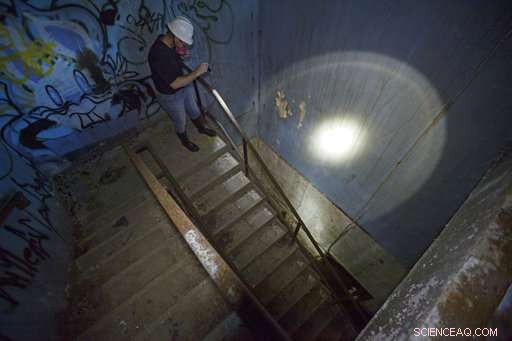 p Nesta terça, 26 de setembro, Foto de 2017, Derek Boese, the Chief Administrative and Public Information Officer for the Southeast Louisiana Flood Protection Authority-East, uses a flashlight to illuminate the stair well of a Cold War era Civil Defense bunker in New Orleans. In a real nuclear disaster, taking cover in a building bearing a rusted yellow fallout shelter symbol may not be the best option anymore. Experts say the shelters in schools and courthouses are often aging relics from the Cold War that haven't been maintained. And conventional wisdom has changed. (Max Becherer /The Advocate via AP)
p Nesta terça, 26 de setembro, Foto de 2017, Derek Boese, the Chief Administrative and Public Information Officer for the Southeast Louisiana Flood Protection Authority-East, uses a flashlight to illuminate the stair well of a Cold War era Civil Defense bunker in New Orleans. In a real nuclear disaster, taking cover in a building bearing a rusted yellow fallout shelter symbol may not be the best option anymore. Experts say the shelters in schools and courthouses are often aging relics from the Cold War that haven't been maintained. And conventional wisdom has changed. (Max Becherer /The Advocate via AP)
-
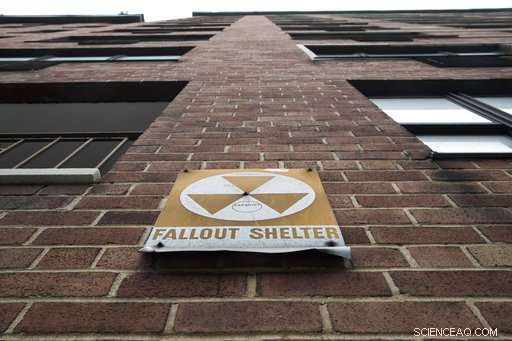 p Nesta terça, Jan. 16, 2018 photo, a fallout shelter sign hangs on a building on East 9th Street in New York. A generation of Americans knew just what to do in the event of a nuclear attack—or during a major false alarm, like the one over the weekend in Hawaii. Take cover in a building bearing the yellow fallout shelter symbol. But these days, that might not be the best option, or even an option at all. (AP Photo / Mary Altaffer)
p Nesta terça, Jan. 16, 2018 photo, a fallout shelter sign hangs on a building on East 9th Street in New York. A generation of Americans knew just what to do in the event of a nuclear attack—or during a major false alarm, like the one over the weekend in Hawaii. Take cover in a building bearing the yellow fallout shelter symbol. But these days, that might not be the best option, or even an option at all. (AP Photo / Mary Altaffer)
p © 2018 Associated Press. Todos os direitos reservados.








